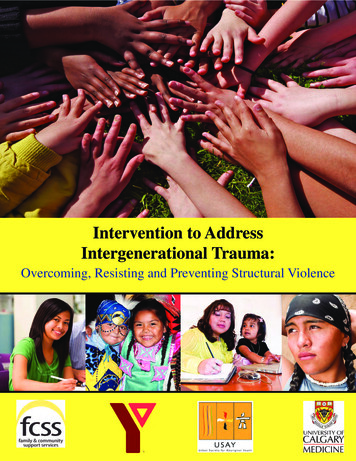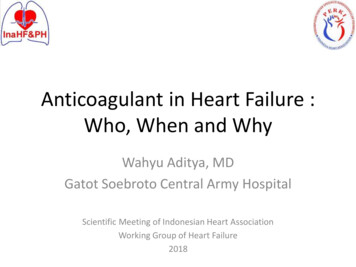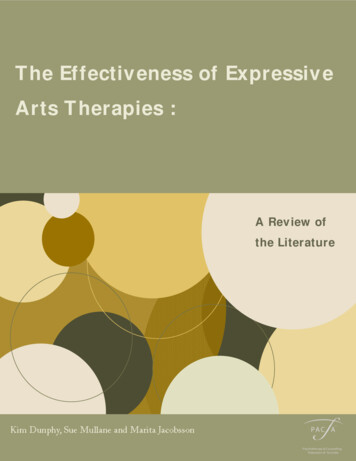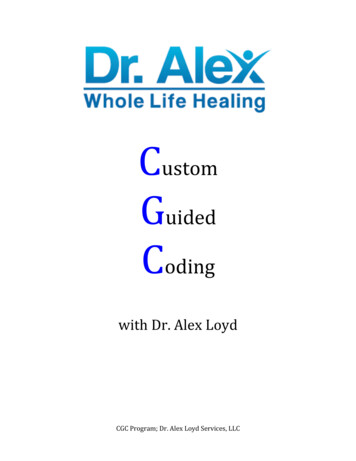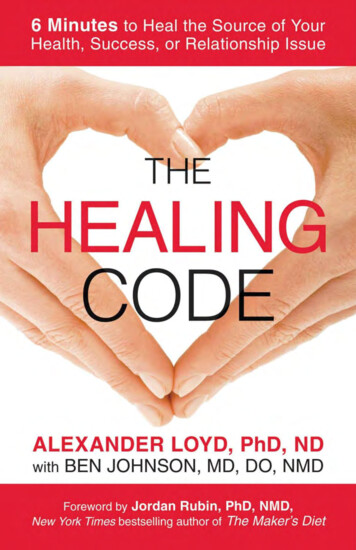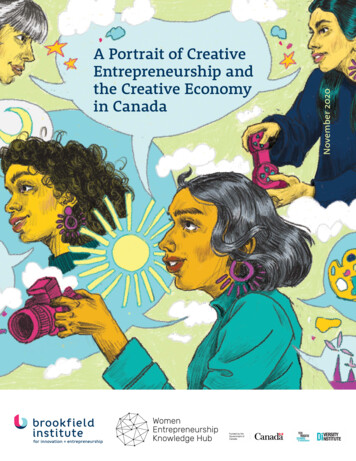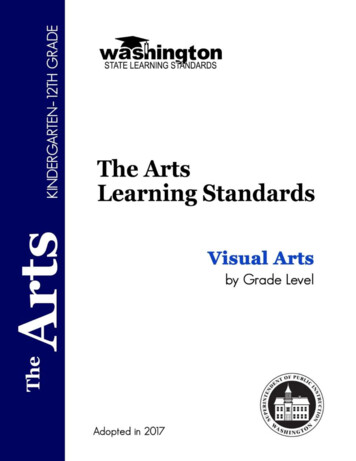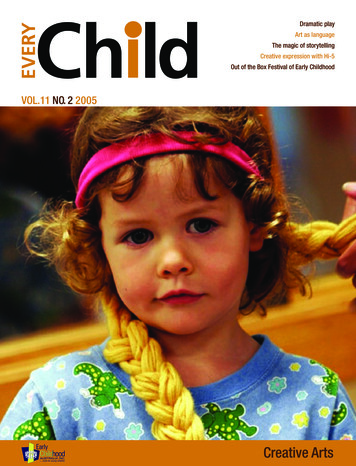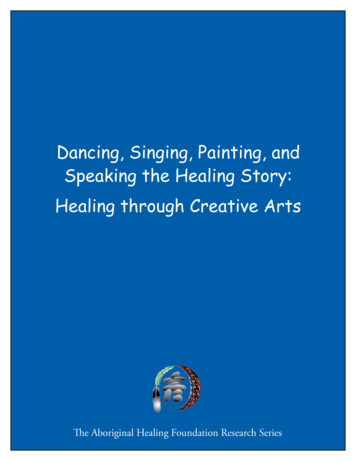
Transcription
Dancing, Singing, Painting, andSpeaking the Healing Story:Healing through Creative ArtsThe Aboriginal Healing Foundation Research Series
2012 Aboriginal Healing FoundationPublished by:Aboriginal Healing Foundation75 Albert Street, Suite 801, Ottawa, Ontario K1P 5E7Phone: (613) 237-4441Toll-free: (888) 725-8886Fax: (613) 237-4442Email: research@ahf.caWebsite: www.ahf.caDesign & Production:Aboriginal Healing FoundationElectronic version:ISBN 978-0-9881274-1-8Unauthorized use of the name “Aboriginal Healing Foundation” and of the Foundation’s logo is prohibited.Non-commercial reproduction of this document is, however, encouraged.This project was funded by the Aboriginal Healing Foundationbut the views expressed in this report are the personal views of the author(s).Ce document est aussi disponible en français.
Photographer: Linda Archibald
Dancing, Singing, Painting, andSpeaking the Healing Story:Healing through Creative ArtsPrepared forThe Aboriginal Healing FoundationByLinda ArchibaldWithJonathan DewarCarrie ReidVanessa Stevens2012
Dancing, Singing, Painting, and Speaking the Healing Story: Healing through Creative ArtsTable of ContentsAcknowledgements. v1. Creative Arts and Healing: An Introduction to the Research Project. 1References. 42. Creative Arts and Healing: An Overview of Indigenous and Western Approaches. 7Indigenous Approaches to Art and Healing. 8Western Approaches to Creative Arts Therapies.11Definitions.13References.143. Creative Arts, Culture, and Healing: Building an Evidence Base. 17Linda Archibald and Jonathan DewarAbstract.17Background.17The Research Process.19Ethical Considerations.20Emerging Themes.21Personal Development: Creative Arts-as-Healing.24Creative Arts-in-Therapy.27Holistic Healing includes Creative Arts.29Issues and Challenges.33Building Relationship/Building Community.34Policy Implications.35Note .37References.384. Voices of Healers. 39Jan Kahehti:io Longboat. Herbalist, Healer. Oshweken, Ontario.40Thais Sewell. Healer. Vancouver, British Columbia.42Jakob Gearheard. Ilisaqsivik Society. Clyde River, Nunavut.44Norman Drynock. Residential School Survivor, Carver, Storyteller, Social Worker.Whitehorse, Yukon.46Darlene Cardinal. Community Activist, Cultural Teacher. Grand Prairie, Alberta.47Carla Johnson. Artist, Counsellor, Educator.Prince Albert, Saskatchewan.48Mike MacInnis. Social Worker, Musician. Eskasoni First Nation, Nova Scotia.49Ernie Blais. Musician, Square Dancer, Fiddle Judge. Winnipeg, Manitoba.50Shirley Flowers. Poet, Therapist. Happy Valley–Goose Bay, Labrador.51Prayer to the Earthkeepers.52Elisapee Davidee Aningmiuq. Cultural Teacher, Counsellor. Iqaluit, Nunavut.525. Rights of Restoration: Aboriginal Peoples, Creative Arts, and Healing. 55Linda Archibald, Jonathan Dewar, Carrie Reid, and Vanessa Stevensvii
Table of ContentsHonouring Your Grief: An Art Therapy Workshop.55Introduction.55Research Methods.56The Participants.57Overview of The Workshop.58Sunday 63Friday.64Discussion.64Safety.65Holding Space.65Modelling.66Interdependent Practice.66Resiliency and Connection.68Read My Tea Leaves Please.68Art and Embodiment.69We Really Just Plant Seeds.70Art and Healing: Summary of Impacts.70Reflections of an Art endix 1:Appendix 2:Appendix 3:Appendix 4:Appendix 5:Appendix 6:Appendix 7:Annotated Bibliography of Selected Creative Arts Therapies Literature.77Creative Arts and Healing Survey.83Creative Arts and Healing Survey – Coded Data.87Creative Arts and Healing Survey Codebook.91Interview Guide for Healers, Counsellors, Helpers, and Therapists.95Interview Consent Form.97Consent Form for Workshop Participants.99Table 1: Creative Arts Activities.19Table 2: Creative Arts-as-Healing.24Table 3: Creative Arts-in-Therapy.28Table 4: Culture, Traditions, and the Creative Arts.30Table 5: Social Relations.34Figure 1: Holistic Healing Restoring Balance.22Figure 2: Creative Arts and Healing: Three Interconnected Models.23viii
Dancing, Singing, Painting, and Speaking the Healing Story: Healing through Creative ArtsAcknowledgementsMany people contributed to the Aboriginal Healing Foundation’s Creative Arts and Healingresearch project: those who took time away from their important work in healing programs acrossCanada to fill out questionnaires and participate in telephone interviews; the entire staff at TsowTun Le Lum Society—especially Yvonne Rigsby-Jones, Nola Jeffery, and Jeff Bob—along with thewonderful participants in the May 2010 Healing Your Grief workshop who welcomed researchersinto their midst; Philip Bird, whose deep knowledge of quantitative research methods made workingwith numbers a pleasure; Jackie Brennan and Flora Kallies for providing so many different kindsof support throughout the project; Jonathan Dewar, Carrie Reid, and Vanessa Stevens who eachcollaborated in their own way and are co-authors of some of the chapters of this report; and MikeDeGagné for his clear and ever-practical vision and leadership.ix
Photographer: Linda Archibald
Chapter 1Creative Arts and Healing:An Introduction to the Research ProjectThis report describes the results of a study by the Aboriginal Healing Foundation (AHF) in the useof creative arts in healing programs. The AHF was established in 1998 with a mandate to supportthe development of sustainable healing processes related to the legacy of Canada’s residentialschool system. Part of this was accomplished through research and evaluation that revealed thesignificant contribution of cultural interventions to healing out of which the Creative Arts andHealing study grew. As Marlene Brant Castellano wrote in Volume I of the AHF’s final report,“Research on promising healing practices points to evidence that cultural activities are legitimateand successful healing interventions” (Castellano, 2006:148). Since many cultural activities arearts-based, questions arose around the use of creative arts in healing programs; in particular, How often are creative arts incorporated into healing programs? What are the associated benefits and challenges?The formal research question guiding this study was, What happens when art, music, dance, storytelling, and other creative arts become apart of community-based Aboriginal healing programs?The three-phase study began in 2009 with a survey of more than 100 AHF-funded healing projectsacross Canada. The survey asked questions about the inclusion of creative arts activities in healingprograms, the benefits and challenges to participants, and the role of healers and therapists. Followup telephone interviews were held with 22 of the healers, helpers, therapists, and counsellorsrecommended by survey respondents. The third phase of the study took place in May 2010 at afive-day art therapy workshop at the Tsow-Tun Le Lum Society’s healing lodge with two researchersin attendance as participant–observers. The workshop was unique in the way it incorporatedWestern art therapy and Coast Salish traditions. The research findings are presented in the variouschapters of this report. Two of the chapters were first published in journals; they are revised hereto reach a wider audience, especially among First Nations, Inuit, and Métis people, communities,and organizations.Underlying the study is an assumption that the need for healing among Aboriginal people has itsroots in the residential school system, and this, in turn, is part of a broader legacy of dislocationand loss that began with the colonization of North America. “Historic trauma” is the term used todescribe the impact of serious and painful losses on a people over time and across generations. It is acollective form of post-traumatic stress disorder (PTSD) embedded in the history of what Aboriginalpeople in North America have experienced and endured. The healing stages involved in addressing1
Linda Archibaldhistoric trauma are similar to healing from PTSD, but the process is more complicated because itmust also address historical factors such as the loss or denigration of language, culture, spirituality,traditional knowledge, lands, and resources. In such cases, learning about or reconnecting withone’s culture and traditions can become a significant part of the healing process. In their study onhistoric trauma, Cynthia Wesley-Esquimaux and Magdalena Smolewski (2004) wrote: “The onlyway to address the healing needs of Aboriginal people is to open culturally-appropriate avenues forproducing change in existing memory structures and belief systems that will allow Aboriginal peopleto regain their collective strength” (2004:80).This paper presents evidence that healing programsfor Aboriginal people are, in fact, doing this and that creative arts and culture are being widely usedin the service of healing. For First Nations, Inuit, and Métis people involved in community-basedhealing programs, the inclusion of arts and culture can counter some of the damage associated withCanada’s history of outlawing and suppressing traditional arts, ceremonies, dances, and rituals.In order to set the stage for understanding Indigenous1 approaches to art and healing, Chapter 2begins with an overview of the use of art, dance, storytelling, and music in ceremonies as well as ineveryday life. This is followed by a short history of the emergence of the profession of art therapy inEurope and North America during the twentieth century. Some of the similarities and differencesamong Indigenous and Western approaches, methods, and world views are discussed. A list ofdefinitions of the various types of creative arts professions is included at the end of the chapter.Chapter 3, “Creative Arts and Healing: Building an Evidence Base,” was originally published inPimatisiwin: Journal of Aboriginal and Community Health in 2010. A revised version is reproducedhere. The article describes the research methods and presents the findings from the survey andthe key informant interviews. The survey confirmed that creative arts are being incorporatedinto healing programs to an extraordinary degree. In fact, only a handful of the 104 projects thatresponded to the survey indicated their programs did not include any creative arts activities, andmore than half of the projects included seven or more creative arts in their healing programs.Reported activities included drawing, painting, carving, beading, sewing, mask making, drummaking, drumming, singing, dancing, drama, poetry, songwriting, storytelling, basket weaving,building a kayak, making snowshoes, traditional cooking, tanning hides, and making sealskinkamiiks.In addition to presenting the research findings, the chapter also puts forward a framework forunderstanding the ways in which creative arts support healing among Aboriginal people. The roleof the arts is explained through three interconnected models of healing: the first focuses on theinnate healing power of creativity (creative arts-as-healing); the second speaks to the use of the artsin the therapeutic process (creative arts-in-therapy); and the third encompasses a holistic approachto healing that includes creative arts, culture, and spirituality within its very definition (holistichealing includes creative arts).The first two models can be found in the existing art therapy literature.The third model, which grew out of the research, was necessary to complete the picture with respectto Aboriginal people because so many of the responses to the survey and interview questions12The terms “Indigenous” and “Aboriginal” are used interchangeably throughout this report.
Creative Arts and Healing: An Introduction to the Research Projecttranscended the two existing models. In these cases, creative arts were considered inseparablefrom culture, spirituality, and holistic healing. Traditional healing encompasses culture, language,history, spirituality, traditional knowledge, art, drumming, singing, dance, and storytelling as wellas knowledge specific to the healer’s area of expertise and the type of healing being undertaken.It is a comprehensive, holistic approach aimed at restoring balance. The chapter concludes with adiscussion of the policy implications of the research.Chapter 4, entitled “Voices of Healers,” includes long excerpts from ten of the key informantinterviews. This provides an opportunity to hear first-hand descriptions of some of the creativehealing work being undertaken by the healers, helpers, and counsellors involved in the study. In all,22 people participated in telephone interviews, including registered art therapists (3), traditionalhealers (3), trauma counsellors (2), social workers and counsellors (5), project coordinators (3),an expressive arts therapist, a cultural worker, a pipe carrier, a psychologist, a cultural teacher,and a literacy teacher. Many are also artists or musicians, and a few identified as residential schoolSurvivors. First Nations, Inuit, Métis, and non-Aboriginal individuals were interviewed, whichincluded 14 women and 8 men. The common denominator among the participating healers,counsellors, and therapists seems to be that none relied solely on talk therapy. Creative arts wereused in ways that engaged the body, the spirit, the emotions, and the intellect. Interviewees had avariety of educational backgrounds and training, with some having both Western and traditionaltraining. A number of the Aboriginal healers and counsellors mentioned coming to their workthrough their own healing, and this had motivated them to seek training in order to share withothers what they had received.“Rights of Restoration: Aboriginal People, Creative Arts, and Healing” (Chapter 5) is presented ina slightly different form than how it appeared in the Fall 2010 issue of The Canadian Art TherapyAssociation Journal. This article describes an art therapy workshop presented by the Tsow-TunLe Lum Society on the Nanoose Bay First Nation in British Columbia. It includes a descriptiveanalysis of the five-day workshop and participant feedback from a focus group held on the fourthevening. The article was authored by the two researchers who participated in the workshop, AHF’sresearch director, and the art therapist who delivered the workshop. The inclusion of these disparateperspectives resulted in an article that attempts to capture in writing some of the creative and nonlinear processes involved in healing through the arts.An annotated bibliography of selected literature is included as Appendix 1. The remainder of theappendices include information that may be useful to other researchers studying the contributionsof creative arts to healing. The Creative Arts and Healing Survey is found in Appendix 2. Appendix3 contains the full set of coded data in table form. The codebook developed to analyze the openended questions in the survey is found in Appendix 4. The codebook was developed inductivelybased on what respondents wrote, and it was revised many times during the coding process. Inthe end, it became a blueprint for the healing models that are presented in Chapter 3. Appendix 5contains the interview guide for the key informant interviews, Appendix 6 is the interview consentform, and Appendix 7 is the consent form for participants in the Tsow-Tun Le Lum art therapyworkshop.3
Linda ArchibaldWhile each of the chapters can be read independently, collectively they cover all of the informationgathered in the three phases of the research: the survey, the key informant interviews, and theparticipant-observation of an art therapy workshop. The conclusions are evident in the presentationof the findings. First Nations, Inuit, and Métis in all regions of Canada are using creative arts inhealing programs, and these interventions are viewed as effective aids to healing. By remainingtrue to traditional approaches to healing and, often, blending them with contemporary therapeuticapproaches, Aboriginal people are successfully addressing many of the wounds of history—historictrauma and the residential school legacy—as well as the personal issues and problems individualseverywhere struggle to overcome. The research supports the therapeutic use of the arts, such as arttherapy, as well as the healing benefits of creative activity in general. It also supports the benefitsof cultural and traditional arts and of traditional healing. There is evidence of the indivisibility oftraditional arts, culture, and healing on the one hand and, paradoxically, the efficacy of Westernarts, especially art therapy and music, on the other. For many Aboriginal people, traditional healing,culture, spirituality, and the arts are often so interconnected that attempts to speak of any onein isolation of the others makes no sense at all. Clearly, creative arts therapies, cultural arts, andtraditional healing contribute to, support, enhance, and deepen the healing process in a multitudeof interconnected ways. As such, they must be recognized as legitimate methods of healing with theassociated financial and programming support.On another note, the research phase of this study coincided with the final years of the AHF mandate.At one time over 400 healing projects received AHF funding, but at the time of the survey, thenumber of active projects had dropped to 137, and the funding for the majority of these ended in June2010.It seemed to be particularly ironic to be writing about all the wonderful creative therapeuticwork that had taken place in programs supported by Aboriginal Healing Foundation funding at atime when many of these programs are no longer in operation and AHF itself is closing. The roleof providing mental health supports to residential school Survivors has been shifted to HealthCanada. It is hoped that Health Canada’s First Nations and Inuit Health Branch funding criteria canbe expanded to include creative arts and cultural programs as valid mental health interventions.ReferencesCastellano, M. Brant (2006). Final Report of the Aboriginal Healing Foundation, Volume I: A Healing Journey:Reclaiming Wellness. Ottawa, ON: Aboriginal Healing Foundation.Wesley-Esquimaux, C. and M. Smolewski (2004). Historic Trauma and Aboriginal Healing. Ottawa, ON:Aboriginal Healing Foundation.4
Drumming at the Mount Elgin Indian Residential SchoolCommemoration and Gathering, June 20/21, 2012Chippewa’s of the Thames First Nation, OntarioPhotographer: Allen Deleary
Chapter 2Creative Arts and Healing:An Overview of Indigenous and Western ApproachesAt this particular moment in time, there is a wonderful convergence between the Western world’sgrowing acknowledgement of the therapeutic value of creative arts and the traditional practices ofmany Indigenous societies where art, music, dance, and storytelling are integral to a holistic approachto life, health, and healing. In an article on the state of the arts and health in Canada, the authorsstate, “In Canada, official recognition of the connection between arts and health is embryonic”(Coxa et. al, 2010:109) compared to England, the United States, and Australia. They are, however,optimistic about the future: “We believe there is an unstoppable momentum wherein new work willsurface, new practitioners will emerge and new connections will be forged” (2010:120). The authorsrecommend that there should be a wide range of program and policy initiatives, including fundingand infrastructure support, increased networking and communications, opportunities created tobuild expertise in the arts and health field, and research and documenting developments in thefield.The growing acceptance of the healing power of the arts among Western-trained medical andmental health professionals situates traditional Aboriginal approaches to health and well-being onthe leading edge of therapeutic healing. For Aboriginal people, traditional arts, culture, spirituality,and healing were, and are, interconnected. While there are many similarities between Western andIndigenous approaches to the creative arts and healing, this is one of the most significant differences.Indigenous approaches include arts and culture in a holistic model of healing that encompasses thephysical, emotional, intellectual, and spiritual world. Marlene Brant Castellano (2010) summarizesAboriginal beliefs about the nature of holistic health and acknowledges movement on the partof some Western approaches, specifically population health, toward a broader perspective that iscloser to the Aboriginal view:Holistic approaches to maintaining and restoring health have been advocated byAboriginal people for many years. This means attending to physical, mental,emotional and spiritual dimensions of persons, across the life cycle for children,youth, adults and elders. It means addressing social and environmental conditionsincluding education, housing, and a compromised natural environment. Holisticthinking is now being embraced in approaches to population health and recognitionthat determinants of health lie outside of the conventional medical domain, butpractice is still firmly rooted in the medical model of treatment. The spiritualdimensions of healing remain mysterious and neglected (2010:12).The following discussion of Indigenous and Western approaches to art and healing provides a briefoutline of the world views and values underpinning the therapeutic use of creative arts in healing.Indigenous approaches focus especially on how arts, culture, and spirituality fi
Dancing, inging, ainting, and peaking the Healing tory: Healing through reative Arts Acknowledgements Many people contributed to the Aboriginal Healing Foundation's Creative Arts and Healing research project: those who took time away from their important work in healing programs across
